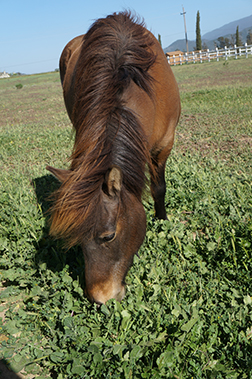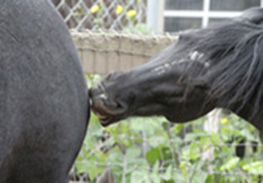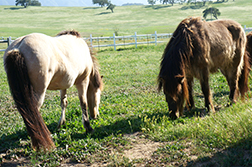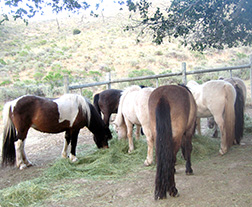|
Natural Life Style and Diet
Just as Natural Hoof Care shapes the hoof in the most natural and physiologically correct way, respecting the structures and mechanisms of the hoof, Natural Hoof Care also takes a holistic view with the horse's long term mental and physical health and well being in mind.
From the earliest horses of the Eocene, 65 million years ago, through the modern horse, Equus, wild horses have lived in social groups, moving and feeding constantly on the sparse dry grasses of their natural range land. In modern times, although our treatment of horses has changed, the basic needs of the horse have not changed.
Besides choosing the healthiest and least restrictive trim for the hooves, each of the following factors contributes to the horse's overall health and well being....

- Choosing the healthiest, most natural diet and feeding practices. The horse's relatively small stomach is adapted to consume small quantities at a time, as he moves from spot to spot, grazing with his head at ground level, throughout the day and night. When we feed our horses rich, concentrated feeds, in large quantities just a few times a day, we disrupt the natural digestive process of the horse, which can lead to many health problems including colic, poor hoof health, and founder. It is recommended to feed only low sugar grass hays, at ground level, in multiple locations to encourage movement, free choice or in frequent small feedings if possible, and limit legumes (such as alfalfa), lush pasture, sweet feeds and grains. Testing the hay for sugar content (NSC) can also be beneficial, especially for easy keepers and horses prone to laminitis.
- Providing the most natural environment possible with adequate opportunities for movement and socialization. Horses need herd interaction to be optimally healthy and happy. Modern horsekeeping practices of stabling horses separately, in small stalls or paddocks, deprives them of both the movement and the herd dynamic so important to their physical and mental well being. Living with a least one other horse in as large a space as possible provides opportunity for quiet interactions such as mutual grooming, eating together, and resting together, and for physical interactions such as running and playing, as well as important expressions of hierarchy and dominance. Other aspects of natural horsekeeping include feeding and watering at ground level, providing different footings, some hard and abrasive such as scraped dry ground or pea gravel, some softer for lying down, such as sand. Areas in which to shelter from sun, wind, and inclement weather are good, but horses should have adequate outdoor space available to them for the majority of the day.
- The horse's skeleton and musculature were not designed to carry weight on its back, so to make weight bearing as undamaging as possible, start young horses later rather than earlier, don't overmount the horse with a rider too heavy for the horse's size, and try to choose the lightest saddle possible, making sure it is properly fitted and carries the rider's weight in a balanced position or ride bareback. The horse's sensitive mouth was designed for eating, not for wearing a bit, so again, try to choose the least intrusive or painful bit possible or use bitless alternatives. Provide adequate warm up and cool down before and after each ride and be sensitive to the horse's level of fitness and enjoyment of his work.
-
Being respectful and considerate in all aspects of our relationship with horses. Since horses existed for somewhere in the range of 65 million years before being domesticated by man, they are certainly more than our mere possessions and it is important that we be mindful of our responsibilities toward those in our care. We can and should choose to handle and ride our horses with gentleness and understanding of both their physical and mental needs.
|




|















